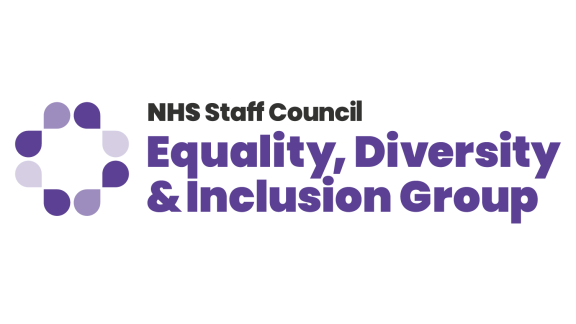Key points
Staff networks are a key mechanism for driving meaningful change and making a difference, as well as empowering people with the opportunity to grow personally and professionally.
Staff networks provide a critical forum for individuals to come together, share ideas, raise awareness of challenges and provide support.

Introduction
The NHS Staff Council’s Equality, Diversity and Inclusion Group (EDIG) has produced this best practice guide to support joint partnership structures to work together with staff networks.
This guidance was developed following a survey and workshops with HR and equality, diversity and inclusion (EDI) representatives, staff-side chairs and staff network chairs. Access the summary of survey results for more detail on the responses we received.
NHS England and NHS Improvement has encouraged all NHS bodies in England to establish staff equality networks and to effectively support them to be a source of staff engagement and key feedback. Support for staff equality networks also forms part of the NHS People Plan’s actions to promote staff health and wellbeing for all.
This guidance uses the term BAME (black, Asian and minority ethnic), this means everyone who self-identifies their ethnicity as other than white British. Staff networks will use their own terms as agreed by the network themselves.
- Download this chapter
- Introduction
Roles and forums
To help understand how joint partnership structures can support staff networks we have included an outline of key roles and forums.
Staff networks
Staff networks are a group of colleagues, often with a shared heritage, experience or a characteristic, that come together to support each other and work with the organisation to improve staff experience. They exist in many different formats across organisations in the public, private, third sectors and the forces and are known by many different names and acronyms.
For example, in Parliament, they are called workplace equality networks (WENs). The most popular networks in most organisations are affinity groups that are linked to the protected characteristics of the Equality Act (2010) covering age, disability, race, religion, sex and sexual orientation.
EDIG’s research found that the top five main areas of focus for staff networks in the NHS were:
- being a safe space to raise concerns
- the experience of staff at work, analysis of data, for example, local NHS Staff Survey results, Workforce Race Equality Standard (WRES) and Workforce Disability Equality Standard (WDES) (England sources)
- action planning
- peer support
- disseminating best practice.
Joint negotiating committee (JNC) or joint partnership group
This is a body within an NHS organisation that is made up of elected, recognised, trained independent trade union representatives known as the staff side and management side representatives including HR. The JNC meets to discuss and consult on issues relating to staff, to negotiate and agree local policies and the implementation of nationally agreed terms and conditions of employment.
Trade union representatives have a range of legal rights to protect their independence and employers have a range of legal and collective agreement obligations to consult and negotiate with their recognised unions. The joint negotiating or partnership forum is the main vehicle for this.
It is good practice for JNCs to include a regular EDI agenda item and to analyse data, including local NHS Staff Survey results and equality data such as the WRES and WDES in England, and support action planning to improve the experience of staff at work.
EDI steering group/committee
This is a free-standing committee that brings together stakeholders such as staff side trade unions, EDI leads, network chairs and board members to advise on and co-ordinate the organisation’s EDI strategy.
Trade union (TU) self-organised group
A network within an individual trade union which enables members with experiences in common to have a voice within the union, and to come together to support and work with each other to challenging discrimination and promoting equality in the workplace.
Health and safety committee
The health and safety committee is a formal committee that includes, managers and trade union safety representatives, working together to keep staff safe and healthy at work, removing potential hazards and reducing incidences of injuries, sickness absence and stress in the workplace.
The board
The board is an organisation’s senior decision-making body, made up of executive and non-executive directors and charged with the effective stewardship of the organisation.
Staff-side chair
A staff-side chair is a leader elected for a set period of time by the recognised trade union representatives who form the staff-side. Most staff-sides will have their own terms of reference and constitution. The role of the staff-side chair is to act as the spokesperson for the trade union group, providing leadership and representing the views of the group and their members fairly and leading negotiations and engagement with the organisation’s management. They also support effective partnership working, engaging with stakeholders and staff to ensure a diverse range of voices are engaged and that negotiation and consultation processes are properly followed.
Trade union (TU) equality representative
An elected representative in individual trade unions who focuses on equality. The role involves promoting fairness at work by encouraging employers to ensure EDI is prioritised within an organisation and ensuring that every member of staff receives fair treatment.
Freedom to speak up ambassador/guardian
A role employed in all NHS trusts in England to provide an alternative way for staff to raise concerns, acting as an independent source of advice., They are supported by voluntary freedom to speak up ambassadors who act as champions for the agenda. They also ensure issues are raised at a senior level of an organisation. The freedom to speak up role was introduced as a result of recommendations from the Francis review of Mid Staffordshire Hospital.
Facility time
This is time off from an individual’s job, granted by the employer, to enable an elected trade union representative to carry out their role. Trade union workplace representatives have a legal right to paid time off for the purpose of carrying out their duties. Duties include collective bargaining on terms and conditions of employment, redundancies, job evaluation, policy development, disciplinary or bullying and harassment as well as representing individual trade union members in disciplinary and grievance proceedings, information and consultation, meeting with management and keeping trade union members informed about negotiations.
- Download this chapter
- Roles and forums
Guidance to joint partnership structures
With the focus on strengthening the role of staff networks, it is likely that most organisations will be looking to set up new networks or review existing ones. Joint partnership structures are well-placed to offer expertise and support to their employer in this work.
This guidance sets how joint partnership structures can work together to facilitate the creation of strong staff networks. This includes establishing effective ways of working across the organisation with clear lines of accountability and understanding of respective roles and responsibilities. This can also support the sustainability of networks, as it ensures that structures are established if staff network or partnership forum representatives change.
1. Set up
Joint partnership structures should offer advice on the following aspects of setting up or reviewing networks.
Maximising participation
Networks need to be inclusive and draw membership from across the whole workforce.
Joint partnership structures can play a role by:
- identifying gaps in demographic data and agreeing actions to improve data levels
- advising on how to get information about the networks to under-represented groups
- getting agreement that all eligible staff are entitled to time off to participate in network meetings and dealing in partnership with any issues or difficulties that arise with this
- liaising with bank, agency and sub-contractor leads to ensure that temporary and sub-contracted workforces are supported to participate in networks.
Support and resources
For networks to be sustainable and effective they need to be supported and resourced.
Joint partnership structures can advise on:
- setting a budget and accounting processes for the network and how admin support will be provided
- drawing up agreements on protected time and backfill for network leadership positions, being clear that this protected time is separate and distinct from trade union facility time, and in situations where these positions are filled by TU reps, this time will be in addition to time off for their trade union role
- other facilities to help networks be effective including access to technology, communications channels, meeting space and events organisation
- identifying and meeting training needs for leadership roles.
See our top 10 tips detailed in the 'getting started' chapter. These tips may help network leads think through their role and how to get started.
Leadership
Networks require leadership teams who can organise the work programme and represent the network in engagements with organisational structures, including the board, the joint partnership forum and other committees.
For networks to thrive, leadership needs to be inclusive and sustainable with attention to succession-planning.
Current practice shows there are a range of different leadership roles in use, including chair, vice-chair secretary, management committees and approaches to filling them, including elections from among the staff eligible for the network, secondments, development time, or creation of specific posts and recruiting to them.
Joint partnership structures can advise on pros and cons and a range of issues which may arise depending on the model chosen:
- Good practice around terms of office, which balance time and space for individual development, against the need to refresh and bring through new leaders.
- The fair and democratic processes for running elections.
- Taking account of the role in appraisals and objective setting.
- Job evaluation issues where specific posts are created – and assessment of the impact of paid roles on ability to speak up.
- Mentoring and support arrangements for leaders – staff side and management-side chairs could play a role in this.
Terms of reference
Joint partnership structures can advise on terms of reference and good practice around reflection and review. Those responsible for setting up a network may want to use our detailed checklist found in the annex.
Joint partnership structures will have particular expertise to offer in areas such as, decision-making and voting, confidentiality and information governance and meeting organisation.
2. Ways of working
EDIG’s research found that the majority of staff network chairs felt that their network would benefit from the support of both HR/EDI and trade union representatives. We also found that when EDI was included as an agenda item at JNCs, that overwhelmingly, the relevant staff network chair was invited to contribute. This provides a good link and can ensure that work programmes complement each other and areas where closer working could be of benefit are identified. At the workshops EDIG ran we often heard about the good relationships in workplaces that have meant potential issues could be resolved quickly.
We also found that many staff network chairs had dual roles such as, trade union reps and freedom to speak up ambassadors, creating natural links between these forums and areas of work. Where this isn’t the case there might not be a formal link between networks and other forums. Setting up a formal relationship between network chairs and joint partnership groups ensures there are structural links which remain, whoever is in post.
Joint partnerships can establish these links in a variety of ways:
- through regular check-ins with management side and staff side leads
- a regular agenda item with contributions from network chairs at JNC meetings
- at relevant sub committees, for example EDI or policy steering groups.
It will also be helpful to agree mechanisms for networks to bringing relevant issues to JNCs, both formally and informally.
Many networks have specific membership positions for staff-side leads which means they can ensure good links and information flow between structures and offer their expertise and support to network members.
Links with health and safety structures
Health and safety committees are another forum where links with staff networks may usefully be established. Bullying and harassment will often be a key health and safety concern for staff networks and one where health and safety committees may well be supporting wider work to change organisational cultures. The NHS Staff Council Health, Safety and Wellbeing Partnership Group has produced useful information on bullying at work: Bullying in healthcare - NHS Employers.
Access to trade unions
While much of the support to networks can and should be provided jointly, it is also beneficial for network leads to have access to staff side leads to seek advice and feedback on areas of concern or intelligence that they may not feel able to raise formally and directly with the employer. Trade union engagement with network members will help identify issues which are more appropriately dealt with as casework rather than networking or peer support.
In England direct channels through to freedom to speak up guardians will also be helpful.
Access to the organisation’s board
Networks will be most effective if they have visible and high-level support and engagement from the board of the organisation. This could take the form of board director sponsors or champions, and regular attendance and reporting at board meetings.
Joint partnership forums can facilitate and support this by ensuring board engagement takes place and ensuring board-level understanding of respective roles, responsibilities and work programmes and how they interact.
3. Work programmes
Staff networks need to identify the priorities their members wish to work on and agree objectives and work programmes which are realistic and achievable. EDIG’s survey found that the areas of their work that network leads felt would most benefit from the support of trade union and EDI/HR support were:
- staff experience
- bullying, harassment and violence
- disseminating best practice and initiatives
- helping to identify members to carry out specific roles such as mentors, recruitment panel members
- pre-emptive vetting of disciplinary proceedings.
- Consultation with Joint partnership structures to establish how network work programmes interact with joint partnership agendas will be key.
There will be key areas of joint negotiating and consultation work to which partnerships may wish to seek input from networks. These include:
- reviewing HR policies
- issues on relevant pay, terms and conditions
- raising concerns
- issues with bullying, harassment and violence
- health and wellbeing.
It's important to agree how this input will be sought including timelines and channels for exchange of information and submission of views. For example, draft policies might be shared with network leads for comments, staff aside and management side might attend network meetings and run engagement sessions on a particular topic.
Organisational action planning around issues of workforce race, disability and other equality strands should be done in partnership. Engaging unions and staff networks as sources of information and feedback on staff experiences and providing opportunities to influence and shape action plans
Joint partnership structures should engage the views of staff networks in assessing and monitoring effectiveness and impact of action plans and formulating changes and improvements.
- Download this chapter
- Guidance to joint partnership structures
Getting started
Top 10 tips for network leads
- Be clear on your super objective – what is it you want to change or make happen, consider a timeline to maintain focus?
- Map out who your stakeholders are/ who you need to influence?
- Articulate who your members will be – map out the membership.
- Develop your terms of reference.
- Establish your governance structure.
- Map your actions to address measurable change – check against your organisation’s inclusion and diversity strategy.
- Develop a communications plan – to attract members and to work on the activities.
- Welcome everyone and listen to their ideas.
- If you are the founder of the network, always bring the work of the network back to the core objective.
- Remember, your role is more to signpost to support, than to solve issues.
Advice on drawing up terms of reference
Things to consider include the following:
1. Aims
- A name for the staff network.
- Its role and responsibilities.
- Who is eligible to participate? Is it only for staff with the relevant protected characteristic or experience, or is it open to allies?
- If it support patients and carers (from specific communities) as well as staff who are also service users who may experience health inequalities
- How the group aligns to the organisation’s vision and values
- How the group aligns to strategic business planning
- Responsibilities under the Equality Act 2010
- How the group reflects the values and beliefs of the NHS Constitution
- Formal terms of reference (see example)
- Implementing a confidentiality clause to:
- give members assurance that issues can be discussed confidentially
- to protect membership identity (for example, not ‘outing’ LGBT staff)
- create a forum where staff have the confidence to openly discuss concerns.
2. Membership
- A process for appointing members.
- Recruiting specific roles such as a chair/ co or vice chair, finance officer and social secretary.
- Ensuring a good gender balance.
- If patient/ public members are involved.
- If there is formal trade union representation within the group.
- Duration of membership.
- Whether members can be removed from the group for inappropriate behaviour.
3. Accountability / reporting
- A structure for reporting on the group’s activities.
- Internal governance processes.
- How the group’s activities will support organisational equality objectives/ frameworks (for example, EDS2 in England).
- How often to review the relevance and value of the group’s work and its terms of reference.
- Producing an annual report.
- Reporting into the organisational governance system.
4. Logistics
- A method/ approach to working (for example, a shared learning approach).
- Secretariat support to organise the meetings.
- The format of meetings.
- The regularity of meetings and where will they be held.
- A budget to provide refreshments.
- Whether the meetings will be face-to-face, virtual or a mixture of the two.
- If the chair of the meetings will be rotated around the group.
- Ways to record discussions (for example, minutes or an action log).
- Generating topics for agendas.
- How and when to circulate meeting papers.
- If non-members can attend meetings.
- Whether any sub groups are required.
5. Communications
- Methods of sharing information and resources with the group.
- Dealing with confidential materials and copyright issues.
- Online functionality for the group (for example, an intranet page) and which members will maintain the content.
An example of a staff network’s terms of reference are shown below.
Example terms of reference
Definition
Black, Asian and minority ethnic (BAME) means everyone who self-identifies their ethnicity as other than white British.
Aims and objectives
The aim of the network is to provide a forum to:
- support BAME staff
- enable BAME staff to feel that they are part of and have a vital role to play in the organisation
- discuss issues affecting BAME staff with key decision makers
- assist in formulating new and reviewing existing policies and procedures
- assist the organisation in meeting its statutory obligations regarding its duty under the Equality Act 2010
- assist in the identification of training needs, advise on the provision of courses to meet those needs, and on the content of courses with equality and diversity implications as they relate to BAME staff
- provide an arena for staff to raise their concerns, in a safe and confidential environment
- provide an opportunity for staff to update each other on local and national policy and developments.
- Download this chapter
- Getting started
Membership
Membership is open to all permanent and temporary staff who work within the organisation and who define themselves as BAME. Membership is renewed annually.
The executive committee and officers
An executive committee will be elected for a 12-month period at the annual general meeting (AGM). The role of the executive committee is to undertake the work of the network in between meetings and represent the network within and outside the organisation.
The executive committee will consist of the following officers:
- Chairperson
- Vice chair
- Secretary
- Communications/ membership officer
- Officer without portfolio
Frequency of meetings
Meetings will be held bimonthly. The terms of reference include scope for smaller work groups to be identified to drive work programmes forward. In the longer term, there may be a need to review the frequency of the meetings on a quarterly basis.
Annual general meeting (AGM)
One of the network meetings will be an annual general meeting to:
- agree list of officers and elect
- review terms of reference
- plan the annual work programme
- present the annual report from the chair of the network.
Quorum
For the staff network meeting to be quorate, there will be an attendance of five members or a quarter of the membership (whatever is greater) for the meeting to take place. The chair or vice chair must be present.
Reporting
The network will report to the organisation’s People Committee (executive forum) and also to its Board committee on Workforce.
Review
The terms of reference will be reviewed annually.
Purpose of the network
1.1. To create a supportive working environment and policy framework for black and minority ethnic (BAME) colleagues while also encouraging all staff within the organisation to understand the needs of BAME individuals within the community.
2. Aims
2.1. To work with the organisation to eliminate discriminations experienced by BAME staff and to promote general equality of opportunity.
2.2. To influence policy making and monitor existing policies to ensure that the BAME equality perspective is proactively considered.
2.3. To provide a support function to colleagues, through the development of virtual networks and meetings, where issues can be openly discussed. Some support may involve signposting staff to external services or trade union representatives.
2.4. To develop and maintain a virtual network that provides support and promotes diversity generally within the workforce.
2.5. To support the organisation with the training of staff at all levels so they can better understand the perspective and needs of BAME staff and service users.
2.6. To gain and share an understanding of the experiences of BAME staff and service users, and highlight any health inequalities that influence service delivery.
2.7. To celebrate the diversity of the workforce by participating in national and local events such as community events and Black History Month (October).
2.8. To promote the service as a healthcare provider and employer within the local BAME communities.
2.9. To promote opportunities for social networking.
3. Membership and representation
3.1. The network will be open to all BAME employees within the organisation. Engagement is also welcomed from other employees who are committed to the aims of the network.
3.2. The network will also be open to colleagues who have a role in supporting the work environment for BAME colleagues and experience of patients.
3.3. It is expected that the majority of the membership will be made up of people who define themselves to be from the black and minority ethnic community.
4. Roles within the network
4.1. The network will elect a chairperson or chairperson to co-ordinate the activities of the network and fulfil the following tasks:
- chair meetings (on a rotational basis if more than one) or delegate to another individual if not available
- set dates for the meetings and organise a suitable space to be available
- set an agenda for each meeting and send this out to participants in advance
- circulate minutes or notes from each meeting to all participants of the group
- be the link person to the diversity and inclusion advisor for the organisation and keep all participants aware of significant changes in the organisation between meetings.
4.2.The network will elect an information officer who will have responsibility for supporting the following functions:
- ensuring an information repository is kept for the network and as much information is made accessible to the group through all available medias
- coordinating information being held on the internet and intranet, linking to information technology colleagues as necessary
- keeping an up-to-date record of members of the group so information can be effectively distributed.
4.3. The network will elect a social officer who will have responsibility for supporting the following functions:
- being aware of all events and networking opportunities within the organisation that the network can link to
- fostering links between the organisation’s BAME network and other similar groups, either within services or other parts of the health economy
- linking with the organisation of a limited number of key events which the network will attend and co-ordinate the organisation’s response
- providing support to colleagues arranging events that link to the BAME community but which the network is not formally involved
- coordinating a limited number of social events around the activities of the group for members of the network and other BAME colleagues within the organisation.
4.4. The election of people into the above roles will take place every six months, recognising that these roles are voluntary and additional to the main job role of each individual.
4.5. Other roles may be allocated to individuals on a temporary or permanent basis dependant on the activities of the group.
4.6. Individuals assuming specified roles within the network can expect to be supported in their role in negotiation with the organisation. This support can take the form of mentorship, relief from normal duties (for a specified number of hours) or expenses.
4.7. The decision making capacity of the group is based on a majority vote being achieved from attendees of any particular meeting. Where it is not possible to apportion a majority, the chairperson will cast the final decision.
5. Frequency of meetings
5.1. The network will meet every month and the locations will be moved around the geographical area of the organisation to enable individuals to attend. It is recognised that no one location is suitable for the whole group and the organisation’s headquarters provides the most central location for ad-hoc events.
5.2. Where it is known in advance that less than four members of the network can attend a meeting, this can be cancelled at the discretion of the chairperson. This is to ensure any decisions made are from a representative sample of the network.
6. Confidentiality
6.1. At no point is anyone under any obligation to declare any information about themselves that they do not wish to share.
6.2. The group will operate a safe space approach to meetings and treat all network members with dignity and respect.
6.3. To assist with confidentiality, records will be kept of attendees to each meeting, but names will not be included on notes or minutes that are circulated outside the group.
7. Records
7.1. The network will keep notes or minutes of each meeting held. Support may be provided from within the organisation to enable this to be complied with. Notes or minutes will be published where members of the organisation can access them on the intranet but no names will be included.
8. Relationships and reporting
8.1. The BAME network will be an autonomous group within the organisation and will link with the organisation’s diversity and inclusion advisor.
8.2. The network may be required to provide brief reports for the organisation’s executive group as and when required. The organisation’s diversity and inclusion advisor will provide assistance if needed to individuals concerned.
8.3. Relationships with key functions may be required, such as the corporate communications team for any externally-facing documentation and for updating the intranet.
- Download this chapter
- Membership



